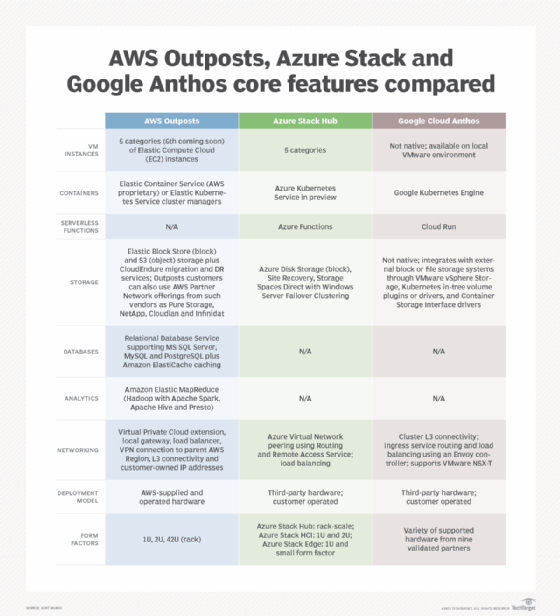
Getty Images
Evaluate Google Anthos for Kubernetes management
Discover the benefits and drawbacks of the Google Anthos platform, and compare it to other options for managing Kubernetes deployments in hybrid and multi-cloud environments.
Over the last two years, Kubernetes has become the preferred container orchestrator for enterprises worldwide. But organizations adopting Kubernetes have found a significant limitation: managing deployments in hybrid cloud environments.
The issue isn't that Kubernetes is incapable of managing cloud or data center containers. Rather, hybrid and multi-cloud applications that need to be orchestrated across clouds and clusters are fragmented because Kubernetes itself fragments resource pools. One way to solve this problem is to use a unifying platform such as Google Anthos.
Managing Kubernetes with Google Anthos
Anthos is a managed application platform optimized for container environments that can also manage VMs and bare-metal deployments. Although the Anthos SaaS tool is offered by Google, the platform can also manage multi-cloud and hybrid cloud deployments on other public clouds. Think of Anthos as an expansion of Google Kubernetes Engine, a Google-specific Kubernetes management platform.
Anthos' goal is to provide the classic single-pane-of-glass view of a complete deployment environment, regardless of how many public clouds, private clusters, VMs or servers are involved. The Anthos dashboard displays all Anthos-controlled resources available to applications, wherever they're hosted. It also shows the state of workloads, services, and the various tools and facilities that Anthos offers.
The Anthos model presumes there is a pool of resources consisting of multiple clusters, clouds and other hosting platforms that operate as a single hosting facility. Organizations with multiple resource pools that each host their own set of applications or components will likely find Anthos to be overkill.
Anthos includes an Istio-based service mesh capability to steer traffic to applications and components -- a key element in support of elastic assignment of microservices to the overall Anthos resource pool. However, that service mesh is unnecessary for applications without a microservices-based, cloud-native design.
Anthos' layered features
Anthos' structure consists of four layers. At the bottom is the set of hosting resources, which includes both public cloud and on-premises hosting in the form of containers, VMs or bare-metal infrastructure. This resource set, which Anthos calls a fleet, is virtualized into Anthos using the Kubernetes control plane.
The fleet's capabilities are then exposed to a multi-cluster fleet automation layer via a set of platform APIs, enabling users to manage traffic, applications and resources consistently, regardless of their type and location. This is the primary point where IT and cloud operations intersect with Anthos and where most operations assistance and observability features are provided.
The fleet automation features encompass operations, governance and security. All three elements interact with the Anthos service mesh for microservices-based applications, meaning that service mesh resources and microservices are both managed in the same way as traditional resources.
Governance is enforced through configuration and policy management, so Anthos can control how fleet resources are used and provide policies and configurations to set the basic operating parameters for the underlying clusters and cloud services. Security provides identity management for workloads and users, centralizing access control and usage policies.
The top layer of Anthos is the developer or deployment layer. Anthos is designed to make all these related processes as independent as possible from the resources in the fleet. However, some application models and resource types might require special attention that Anthos can't fully provide -- for example, microservices architectures or VMs and bare-metal resources.
Consequently, users who plan to use noncontainer resources should review how well Anthos can support their configuration and deployment. Before adopting the platform, ensure you can adapt your use of these resources to minimize incompatibilities.
Choosing a hybrid cloud management tool
Anthos is a Google product, but it's not Google specific -- although Google Cloud users should strongly consider Anthos for hybrid and multi-cloud deployments. Other options include products from Google's major cloud competitors, namely AWS Outposts and Microsoft Azure Arc, as well as software platforms such as Red Hat OpenShift and VMware Tanzu.
Anthos vs. Red Hat OpenShift and VMware Tanzu
To decide which tool is best for you, start by determining what your pool of resources looks like and what kinds of applications you're running. Consider a software tool such as OpenShift or Tanzu if you're managing hybrid or multi-cloud deployments where data center or private edge computing resources are a major contributor to the pool, especially if you want maximum portability across all public clouds.
If you already use OpenShift or Tanzu, check whether it can also serve as your overall hybrid or multi-cloud manager before adding a cloud provider tool such as Anthos. Even if you're not currently using either platform, explore both options to avoid paying for hosted management.
Anthos vs. AWS Outposts and Azure Arc
All three public cloud giants have their own hybrid cloud tool. However, unlike Google Cloud, AWS and Azure define hybrid cloud as an environment where enterprise-owned resources are attached to a public cloud, either in the data center or as an edge element. Thus, they focus on transporting public cloud hosting features outward into the customer's infrastructure.
Azure Arc does offer a multi-cloud stack, but compared with Anthos, it's often less effective in fully virtualizing a complex hybrid or multi-cloud resource pool. On the other hand, AWS Outposts is best suited to on-premises edge computing, rather than a hybrid cloud that uses extensive data center resources.

Anthos is the most generalized of all the tools in its class, offering management as a service for virtually any set of resources or deployment model. Its only real weakness is the as-a-service delivery approach: Smaller organizations might find Anthos unnecessarily expensive if they don't use all its features.
As the smallest of the big three cloud providers, Google is also more accommodating to the other providers in multi-cloud deployments. And unlike AWS Outposts and Azure Arc, Anthos is Kubernetes specific, making it the best choice for organizations whose dominant deployment model is containers. Altogether, this makes Anthos well suited to Kubernetes management in complex hybrid and multi-cloud environments.







